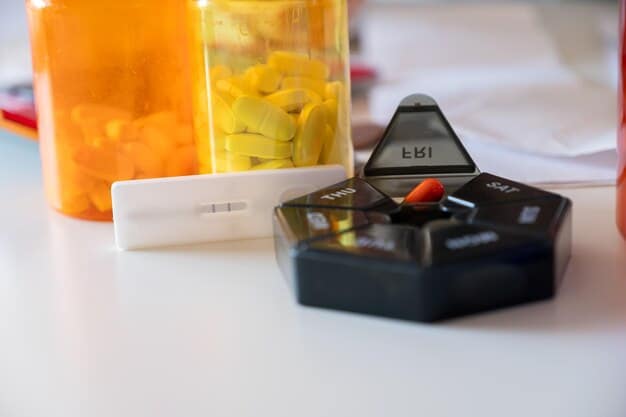Technology for Caregivers: Simplify Life with Smart Home Devices & Apps

Technology for caregivers encompasses smart home devices and apps designed to simplify daily tasks, enhance safety, and improve overall quality of life for both caregivers and their loved ones.
Caring for a loved one can be incredibly rewarding, but it also presents numerous challenges and demands on your time and energy. Thankfully, technology for caregivers is rapidly evolving, offering innovative solutions to simplify your life and provide better care.
Technology for Caregivers: Smart Home Solutions
Smart home technology offers a wide array of solutions to enhance the safety, comfort, and convenience of both caregivers and those they care for. These devices can assist with everything from monitoring vital signs to managing medications and preventing wandering.
Smart Home Devices for Safety
Safety is a primary concern for caregivers. Smart home devices can provide an added layer of security and peace of mind by preventing falls, monitoring activity, and alerting caregivers to potential emergencies.
- Smart sensors: These sensors can be placed on doors, windows, and cabinets to monitor activity and alert caregivers if a loved one is wandering or attempting to access unsafe areas.
- Fall detection devices: Wearable devices or sensors placed throughout the home can detect falls and automatically call for help, ensuring a quick response in case of an accident.
- Smart security cameras: These cameras allow caregivers to remotely monitor their loved one’s activity, ensuring their safety and well-being, especially when they cannot be physically present.
Investing in smart home devices for safety can significantly reduce the risk of accidents and provide caregivers with greater peace of mind. By proactively addressing potential hazards, these technologies can help maintain a safe and secure environment for loved ones.

Medication Management Apps and Devices
Managing medications can be a complex and time-consuming task for caregivers. Fortunately, various apps and devices are designed to simplify this process, ensuring that medications are taken on time and in the correct dosage.
These tools help to reduce medication errors, improve adherence, and provide caregivers with greater control over their loved one’s medication regimen. Effective medication management is crucial for maintaining health and preventing complications.
Medication Reminder Apps
Medication reminder apps send notifications to both caregivers and patients, reminding them when it’s time to take medications. These apps often include features such as dosage tracking, refill reminders, and the ability to communicate with healthcare providers.
- Timely reminders: Notifications ensure medications are taken on schedule.
- Dosage tracking: Records of medication intake help manage and monitor adherence.
- Refill alerts: Notifications prevent running out of essential medications.
Medication reminder apps are an affordable and effective way to improve medication adherence and reduce the risk of errors. They provide a simple yet powerful solution for managing complex medication schedules.
Smart pill dispensers are another useful tool for medication management. These devices automatically dispense medications at the correct time, reducing the risk of missed doses or double dosing. Some dispensers also include features such as remote monitoring and alerts for caregivers.

Voice Assistants for Caregivers
Voice assistants like Amazon Echo and Google Home can be incredibly helpful for caregivers, providing hands-free assistance with various tasks. These devices can be used to set reminders, make calls, play music, and control other smart home devices.
How Voice Assistants Can Help
One of the key benefits of voice assistants is their ability to simplify communication. Caregivers can use voice commands to make calls to family members, healthcare providers, or emergency services, without having to fumble with a phone.
- Hands-free communication: Easily connect with family and healthcare providers.
- Reminders and alerts: Set reminders for appointments, medications, and other important tasks.
- Entertainment and engagement: Play music, podcasts, or audiobooks to engage and entertain loved ones.
Voice assistants can also be used to control other smart home devices, such as lights, thermostats, and door locks. This allows caregivers to create a comfortable and safe environment for their loved ones with minimal effort.
Incorporating voice assistants into your caregiving routine can significantly reduce stress and improve efficiency. By leveraging the power of voice commands, caregivers can focus on providing quality care and support to their loved ones.
Remote Monitoring and Telehealth
Remote monitoring technologies allow caregivers to keep track of their loved one’s health and well-being from a distance. These tools can include wearable devices that track vital signs, sensors that monitor activity levels, and telehealth platforms that facilitate virtual medical consultations.
Benefits of Remote Monitoring
Remote monitoring can provide caregivers with valuable insights into their loved one’s health, allowing them to detect potential problems early and intervene proactively. This can lead to better health outcomes and fewer hospitalizations.
Telehealth platforms enable caregivers to connect with healthcare providers remotely, saving time and travel expenses. These virtual consultations can be used to discuss health concerns, adjust medications, and receive expert advice from the comfort of home.
By leveraging remote monitoring and telehealth technologies, caregivers can enhance their ability to provide comprehensive and timely care, even when they cannot be physically present. These tools empower caregivers to make informed decisions and ensure that their loved ones receive the best possible care.
Apps for Organization and Communication
Caregiving often involves coordinating schedules, managing appointments, and communicating with multiple family members and healthcare providers. Several apps are designed to streamline these tasks, making it easier for caregivers to stay organized and connected.
Key Features of Caregiving Apps
These apps typically include features such as shared calendars, task lists, communication platforms, and document storage. By centralizing all relevant information in one place, caregivers can reduce the risk of miscommunication and ensure that everyone is on the same page.
Shared calendars allow family members to coordinate schedules and appointments, ensuring that someone is always available to provide care. Task lists help caregivers keep track of daily tasks and prioritize their workload.
Communication platforms facilitate seamless communication between caregivers, family members, and healthcare providers. Document storage provides a secure place to store important medical records, insurance information, and other essential documents.
By using caregiving apps, families can create a more collaborative and supportive caregiving environment. These tools empower caregivers to manage their responsibilities effectively and provide the best possible care for their loved ones.
The Future of Technology in Caregiving
As technology continues to evolve, the future of caregiving is likely to be shaped by even more innovative solutions. Artificial intelligence (AI), robotics, and virtual reality (VR) are just a few of the emerging technologies that have the potential to transform the caregiving landscape.
Emerging Technologies in Caregiving
AI-powered virtual assistants can provide personalized support and companionship to seniors, helping to combat loneliness and cognitive decline. Robotic caregivers can assist with tasks such as lifting, bathing, and feeding, reducing the physical strain on human caregivers.
VR technology can be used to create immersive and engaging experiences for seniors, such as virtual travel, therapy sessions, and social activities. These experiences can help to improve cognitive function, reduce anxiety, and enhance overall well-being.
The integration of these emerging technologies into caregiving has the potential to revolutionize the way we provide care for our aging population. By embracing innovation, we can create a more sustainable, affordable, and compassionate caregiving system.
| Key Point | Brief Description |
|---|---|
| 🏠 Smart Home Safety | Sensors and cameras enhance home security. |
| 💊 Medication Management | Apps and dispensers ensure timely medication. |
| 🗣️ Voice Assistants | Hands-free help for communication and tasks. |
| 📞 Telehealth | Remote health monitoring and virtual doctor visits. |
FAQ
▼
Smart home devices like smart speakers, security cameras, and medication dispensers offer a range of support functionalities, from communication to safety monitoring, making caregiving more manageable.
▼
Medication reminder apps send timely notifications, track dosages, and provide refill alerts, ensuring medications are taken as prescribed and reducing the risk of missed doses.
▼
Voice assistants offer hands-free communication, set reminders, and control other smart devices, improving efficiency and safety in caregiving environments without requiring constant physical interaction.
▼
Remote monitoring devices track vital signs and activity levels, providing insights for early detection of potential issues, enabling caregivers and healthcare providers to intervene proactively and avoid complications.
▼
Apps for caregivers offer shared calendars, task lists, and communication platforms, streamlining coordination and ensuring all family members and healthcare providers stay informed and connected.
Conclusion
The realm of technology for caregivers is vast and continuously expanding, offering a multitude of tools and resources to simplify daily tasks, enhance safety, and improve the overall quality of life for both caregivers and their loved ones. By embracing these innovations, caregivers can navigate their responsibilities with greater ease and confidence.





